Fiat 500 vs Hyundai Kona – Which model is better for everyday use?
Everyday use, family trips or long-distance drives – here’s where the differences show.
Discover whether Fiat 500 or Hyundai Kona fits your lifestyle better.
Costs and Efficiency:
When it comes to price and running costs, the biggest differences usually appear. This is often where you see which car fits your budget better in the long run.
Fiat 500 has a slight advantage in terms of price – it starts at 21400 £, while the Hyundai Kona costs 23100 £. That’s a price difference of around 1637 £.
In terms of energy consumption, the advantage goes to the Fiat 500: with 13 kWh per 100 km, it’s to a small extent more efficient than the Hyundai Kona with 14.60 kWh. That’s a difference of about 1.60 kWh.
As for range, the Hyundai Kona performs distinct better – achieving up to 514 km, about 183 km more than the Fiat 500.
Engine and Performance:
Power, torque and acceleration say a lot about how a car feels on the road. This is where you see which model delivers more driving dynamics.
When it comes to engine power, the Hyundai Kona has a significantly edge – offering 218 HP compared to 118 HP. That’s roughly 100 HP more horsepower.
In acceleration from 0 to 100 km/h, the Hyundai Kona is somewhat quicker – completing the sprint in 7.80 s, while the Fiat 500 takes 9 s. That’s about 1.20 s faster.
In terms of top speed, the Hyundai Kona performs evident better – reaching 210 km/h, while the Fiat 500 tops out at 150 km/h. The difference is around 60 km/h.
There’s also a difference in torque: Hyundai Kona pulls somewhat stronger with 265 Nm compared to 220 Nm. That’s about 45 Nm difference.
Space and Everyday Use:
Cabin size, boot volume and payload all play a role in everyday practicality. Here, comfort and flexibility make the difference.
Seats: Hyundai Kona offers slightly more seating capacity – 5 vs 4.
In curb weight, Fiat 500 is slight lighter – 1330 kg compared to 1370 kg. The difference is around 40 kg.
In terms of boot space, the Hyundai Kona offers decisively more room – 466 L compared to 185 L. That’s a difference of about 281 L.
In maximum load capacity, the Hyundai Kona performs significantly better – up to 1300 L, which is about 750 L more than the Fiat 500.
When it comes to payload, Hyundai Kona evident takes the win – 490 kg compared to 305 kg. That’s a difference of about 185 kg.
Who wins the race?
The Hyundai Kona proves to be is largely superior and therefore becomes our DriveDuel Champion!
Hyundai Kona is the better all-rounder in this comparison.
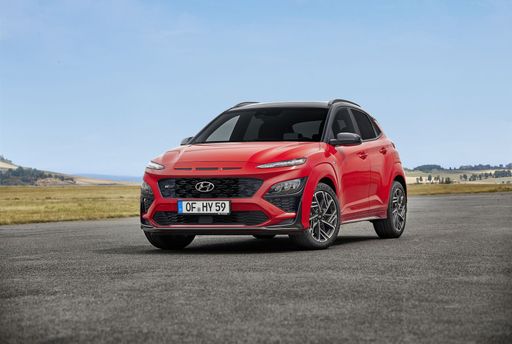
Hyundai Kona
Fiat 500
The Fiat 500 is a compact and stylish city car that has captured the hearts of urban drivers with its charming retro design. Its nimble handling and efficient engine make navigating tight city streets a breeze, while its cosy interior offers a surprising amount of comfort and modern technology. The car's iconic silhouette and vibrant colour options ensure it stands out, offering a unique blend of timeless appeal and contemporary flair.
details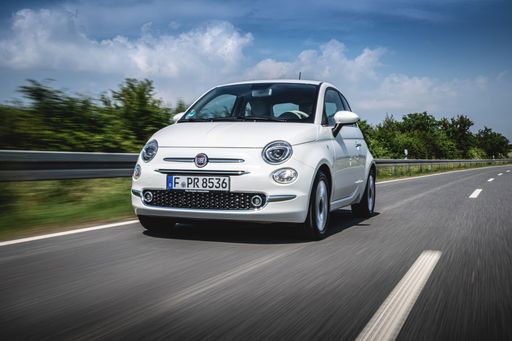 @ media.stellantis.com
@ media.stellantis.com
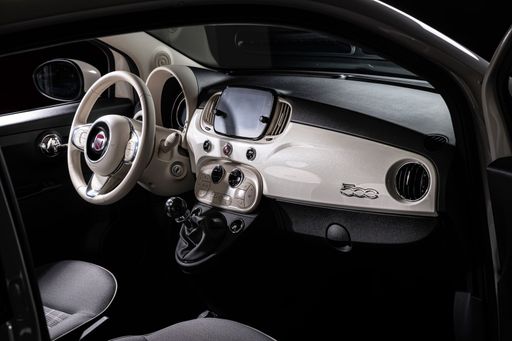 @ media.stellantis.com
@ media.stellantis.com
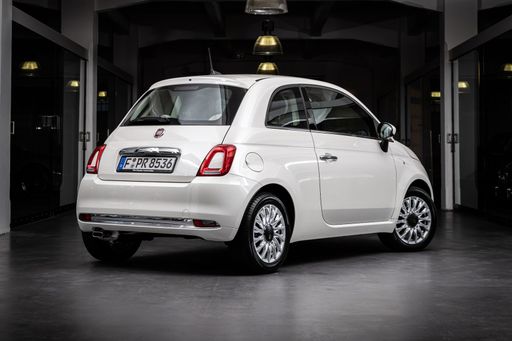 @ media.stellantis.com
@ media.stellantis.com
Hyundai Kona
The Hyundai Kona blends a bold design with a versatile interior, making it a standout choice in the compact SUV market. Its crisp handling and responsive steering provide an engaging driving experience, whether in the city or on the open road. The vehicle also offers a range of features designed to enhance comfort and connectivity, ensuring a pleasurable journey for both driver and passengers.
details @ hyundai.news
@ hyundai.news
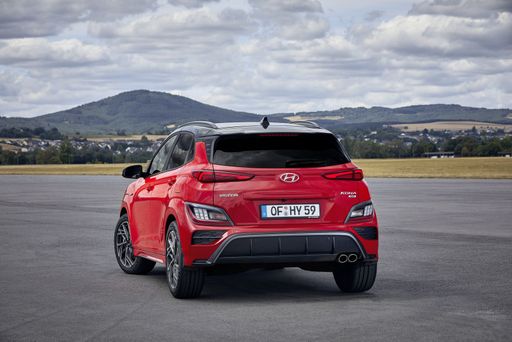 @ hyundai.news
@ hyundai.news
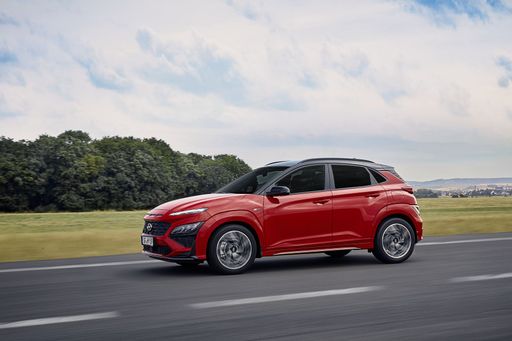 @ hyundai.news
@ hyundai.news
 @ hyundai.news
@ hyundai.news

|

|
|
|
|
Costs and Consumption |
|
|---|---|
|
Price
21400 - 30800 £
|
Price
23100 - 41600 £
|
|
Consumption L/100km
-
|
Consumption L/100km
4.6 - 7 L
|
|
Consumption kWh/100km
13 - 14.7 kWh
|
Consumption kWh/100km
14.6 - 16.8 kWh
|
|
Electric Range
190 - 331 km
|
Electric Range
377 - 514 km
|
|
Battery Capacity
21.3 - 37.3 kWh
|
Battery Capacity
1.3 - 65.4 kWh
|
|
co2
0 g/km
|
co2
0 - 163 g/km
|
|
Fuel tank capacity
-
|
Fuel tank capacity
38 - 47 L
|
Dimensions and Body |
|
|---|---|
|
Body Type
Hatchback
|
Body Type
SUV
|
|
Seats
4
|
Seats
5
|
|
Doors
3 - 4
|
Doors
5
|
|
Curb weight
1330 - 1475 kg
|
Curb weight
1370 - 1773 kg
|
|
Trunk capacity
185 L
|
Trunk capacity
466 L
|
|
Length
3632 mm
|
Length
4350 - 4385 mm
|
|
Width
1683 mm
|
Width
1825 mm
|
|
Height
1527 mm
|
Height
1580 - 1585 mm
|
|
Max trunk capacity
550 L
|
Max trunk capacity
1300 L
|
|
Payload
250 - 305 kg
|
Payload
420 - 490 kg
|
Engine and Performance |
|
|---|---|
|
Engine Type
Electric
|
Engine Type
Electric, Petrol, Full Hybrid
|
|
Transmission
Automatic
|
Transmission
Automatic, Manuel
|
|
Transmission Detail
Reduction Gearbox
|
Transmission Detail
Manual Gearbox, Dual-Clutch Automatic
|
|
Drive Type
Front-Wheel Drive
|
Drive Type
Front-Wheel Drive, All-Wheel Drive
|
|
Power HP
95 - 118 HP
|
Power HP
115 - 218 HP
|
|
Acceleration 0-100km/h
9 - 9.5 s
|
Acceleration 0-100km/h
7.8 - 11.9 s
|
|
Max Speed
135 - 150 km/h
|
Max Speed
162 - 210 km/h
|
|
Torque
220 Nm
|
Torque
200 - 265 Nm
|
|
Number of Cylinders
-
|
Number of Cylinders
3 - 4
|
|
Power kW
70 - 87 kW
|
Power kW
85 - 160 kW
|
|
Engine capacity
-
|
Engine capacity
998 - 1598 cm3
|
General |
|
|---|---|
|
Model Year
2023 - 2025
|
Model Year
2024 - 2025
|
|
CO2 Efficiency Class
A
|
CO2 Efficiency Class
A, D, C, E, F
|
|
Brand
Fiat
|
Brand
Hyundai
|
What drivetrain options does the Fiat 500 have?
The Fiat 500 is offered with Front-Wheel Drive.
The prices and data displayed are estimates based on German list prices and may vary by country. This information is not legally binding.
